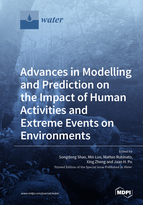Advances in Modelling and Prediction on the Impact of Human Activities and Extreme Events on Environments
A special issue of Water (ISSN 2073-4441). This special issue belongs to the section "Water Resources Management, Policy and Governance".
Deadline for manuscript submissions: closed (31 January 2020) | Viewed by 78677
Multi-corresponding authors are allowed
Special Issue Editors
Interests: River and coastal hydrodynamics; Fluid-structure interaction; Porous flow; Multi-phase flow; Numerical method
Interests: Wave hydrodynamics; Two-phase flow in coastal/ocean engineering; Wave–structure interaction; Sloshing & sloshing mitigation; Cavitation; Meshfree numerical method
Special Issues, Collections and Topics in MDPI journals
Interests: hydraulics; environmental fluid mechanics; urban and coastal flooding; sustainable urban drainage systems; pollutant transport; river regulation; dynamic water surface patterns; advanced experimental flow measurement; climate change mitigation and adaptation
Special Issues, Collections and Topics in MDPI journals
Interests: Wave–structure interactions; High-speed ship hydrodynamics; Sloshing & slamming; Ice–ship interactions; Ice dynamics; Meshfree numerical method
Interests: river hydrodynamics; numerical method; flow measurement; acoustic doppler velocimetry; flow-structure interaction; flow turbulence; sediment transport; vegetated flow
Special Issues, Collections and Topics in MDPI journals
Special Issue Information
Dear Colleagues,
Coastal and river ecosystems are of significant social, economic, and biological value. These areas, however, suffer frequently from natural disasters, such as flooding, erosion, and contamination with pollutants. Substantial research efforts have been devoted to investigating the underlying causes, evaluating the impacts, and identifying various mitigation strategies to reduce their negative effects on society. Despite this, we still face a much more challenging situation than ever due to global climate change and the increase in urbanization.
This special issue aims to gather the latest developments in advanced numerical and other technologies to predict and evaluate the changes in river and coastal environments, thus providing a valuable reference for the regulation of extreme events and human activities. The scope includes, but is not limited to, the forecast of extreme waves and rainfalls; numerical and experimental modeling of flooding; morphological evolution of coastal lines and rivers; dispersion of any contaminants in rivers and coastal areas; coastal and river hydrodynamics linked to any extreme events, such as hurricanes and tsunamis; and local and global erosion and sedimentation in related fields. Although the special issue aims to collect state-of-the art research in the numerical field, interesting works in the analytical and experimental fields are also welcome.
Dr. Songdong Shao
Dr. Min Luo
Dr. Matteo Rubinato
Dr. Xing Zheng
Dr. Jaan H. Pu
Guest Editors
Manuscript Submission Information
Manuscripts should be submitted online at www.mdpi.com by registering and logging in to this website. Once you are registered, click here to go to the submission form. Manuscripts can be submitted until the deadline. All submissions that pass pre-check are peer-reviewed. Accepted papers will be published continuously in the journal (as soon as accepted) and will be listed together on the special issue website. Research articles, review articles as well as short communications are invited. For planned papers, a title and short abstract (about 100 words) can be sent to the Editorial Office for announcement on this website.
Submitted manuscripts should not have been published previously, nor be under consideration for publication elsewhere (except conference proceedings papers). All manuscripts are thoroughly refereed through a single-blind peer-review process. A guide for authors and other relevant information for submission of manuscripts is available on the Instructions for Authors page. Water is an international peer-reviewed open access semimonthly journal published by MDPI.
Please visit the Instructions for Authors page before submitting a manuscript. The Article Processing Charge (APC) for publication in this open access journal is 2600 CHF (Swiss Francs). Submitted papers should be well formatted and use good English. Authors may use MDPI's English editing service prior to publication or during author revisions.
Keywords
- Advanced numerical modeling
- Coastal and river flooding
- Morphology processes
- Contaminant transport
- Extreme events (storm, hurricane, and tsunami)










